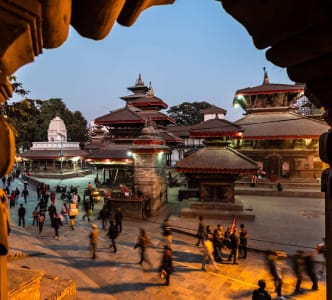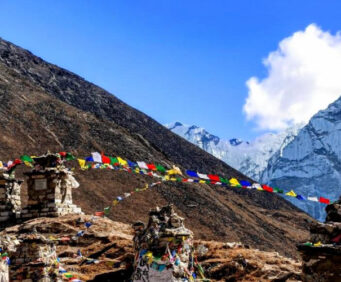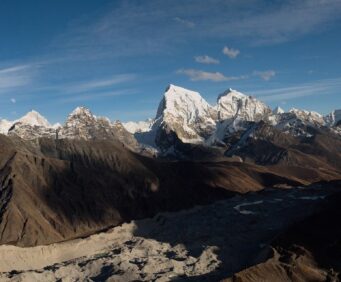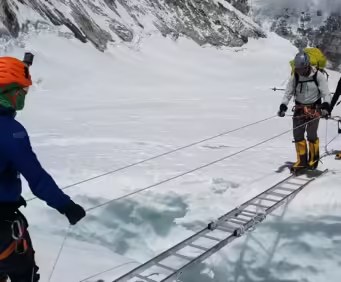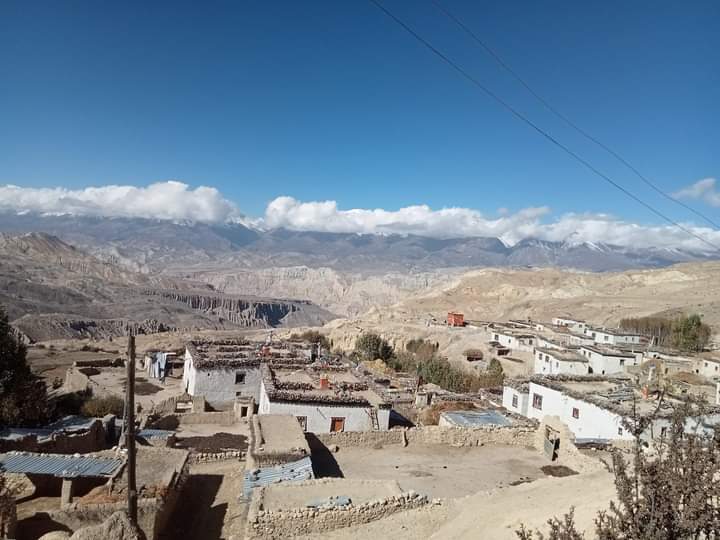
Upper Mustang Trek in Nepal- Explore the Himalaya Kingdom Lo-manthang
7th January, 2024 - Posted By: Himalayan AbodeA great deal of interest in the Forbidden Kingdom of Upper Mustang has been aroused in trekkers worldwide. And it’s understandable why! Trekking paradise can be found in this region of strange rock formations, spiky glaciated peaks, and Buddhist culture. Part of the Tibetan plateau is the high-altitude desert known as Upper Mustang. The walk is a truly off-the-beaten-path adventure, culminating at the legendary walled city of Lo Manthang.
Overview
A wild and desolate country surrounded by an ocean of snow-capped peaks is located behind the majestic Annapurna Massif. This is the Kingdom of Lo, also referred to as the Forbidden Kingdom of Mustang. It is bordered by Tibet and separated from the rest of Nepal.
In the eighteenth century, the country of Nepal annexed it after it had been an autonomous country. Sadly, Mustang lost its royal status when Nepal became a republic in 2008. Upper Mustang has a distinct culture, an untamed mountainous terrain, and is essentially unspoiled. Having said that, a road is being built and could soon alter the area’s personality.
You board the breathtaking flight to Jomsom from Pokhara, the entry point to the Annapurnas. From here, you begin your northward adventure into Lower Mustang and ascend to Upper Mustang, which is frequently referred to as Little Tibet. You go into a completely new universe with drastically altered sights, sounds, and scents. The path essentially tracks the path of the Kali Gandaki River as it carves through the desolate, arid terrain.
For millennia, people have been living in glorious isolation—or maybe surviving would be a better word. The settlements can cultivate their barley, potatoes, and other vegetables thanks to clever irrigation systems. The verdant, terraced fields appear as a veritable oasis from a distance amidst the otherwise desolate lunar landscape.
You may be able to visit a number of the well-preserved stupas, main walls, and gompas (monasteries) that you pass along the route. The journey progressively rises to Lo Manthang, the principal town of Upper Mustang (3,810m). This enigmatic walled “city” was founded in 1340 and hasn’t changed much since then. The trip’s high point is arriving here, where we spend a few nights to get a taste of what living is like in this isolated, high location.
When is the best time to go on the Upper Mustang Trek?
The monsoon rains, which occur in Nepal from June to the middle of September, affect the majority of trekking destinations. The treks can still be completed, although the vistas may be limited and the experience exceedingly soggy. There is an exception in the Upper Mustang region.
This high-altitude desert has dry weather and crystal clear days during this time of year, as it is situated in the Annapurnas’ rain shadow. It’s interesting to note that summertime is also a peaceful season. You will own the best teahouses. The seasons of spring and autumn are the busiest.
The Tiji Festival takes place in May. A lot of hikers enjoy combining this customary celebration with their adventure. The three-day celebration is held on the grounds of Mustang’s old monarch’s palace. To take part in the celebration, people go from far and wide to Lo Manthang, the capital of Upper Mustang. Winter trekking in the Upper Mustang is possible, but it’s chilly, so make sure you pack appropriately.
Difficulty of Upper Mustang Trek
Altitude trekking is never truly easy. During the initial days of trekking, there will be some gasping and puffing as it takes some time to acclimate. At 2,800 meters, the Upper Mustang journey begins relatively high; nonetheless, the height climb is quite moderate. Is this hike any easier as a result? Not exactly, though.
Certain days are particularly long—up to 22 kilometers. While walking, the combination of high altitude, dry air, and strong winds can be somewhat uncomfortable. Therefore, even if the hike is technically easy, there are days when it can be really difficult and require perseverance and strength. Verify your fitness!
What to expect on the Upper Mustang Trek
Amidst China’s engagement in the region, the building of a road from Jomsom into Nepal’s Upper Mustang region has brought about several repercussions, both favorable and negative. Positively, the road has made it easier to transport people, medical supplies, and goods by significantly improving connections.
Economic opportunities may arise as a result of this improved accessibility, especially in the areas of trade and tourism-related operations. Encouraging the construction of rest areas and gas stations is one way to boost the region’s overall economic growth.
Nevertheless, despite these beneficial developments, others have expressed worries, namely about the possible effects on Upper Mustang’s distinctive environment and culture. Cultural heritage places may be threatened by rising tourism and environmental degradation as a result of increased human activity. Social dynamics within the community may shift as a result of the immigration wave.
Notably, the region is made even more difficult by China’s presence. China may influence how the route develops and affects the area through its infrastructure initiatives, economic alliances, and geopolitical interests in Nepal. This may have effects on regional geopolitics, cross-border trade, and economic dynamics.
What does this imply for the Upper Mustang trek in the future? 4X4 vehicles can already travel the entire length of the (dirt) route to the Chinese border. The old hiking paths have been redirected by trekking firms away from the road, traveling through towns that have not been significantly impacted by the new construction. Is it possible for the area to maintain its distinct cultural history and pristine alpine environment? We’ll find out in time.
Itinerary for Upper Mustang Trek
You get the opportunity to fully immerse yourself in the distinctive Tibetan culture and terrain during this 14-day journey deep into the Upper Mustang Trek. Come along on this walking adventure off the main path with us.
Day 1. Drive to Pokhara
We’ll take the Prithvi Highway early in the morning to reach the stunning Pokhara Valley. The Western Himalayas are visible throughout this picturesque six to seven-hour bus trip. You will have time to visit Pokhara, the stunning city by the lake, once you arrive. Or you could take a boat ride in the glistening Phewa Lake. We’re going to stay the night in a nearby hotel.
Day 2. Fly to Jomsom and trek to Kagbeni
From Pokhara, we will take a plane to Jomsom, one of the major towns in Mustang. The trip there will take about twenty minutes. From Pokhara, we will fly northwest across the world’s deepest gorge, which is located between Annapurna and Dhaulagiri. During your flight, you will be treated to breathtaking views of the hills and mountains.
We will hike three hours uphill beside Kali Gandaki from Jomsom to Kagbeni, the entry point to Upper Mustang. Situated on the banks of two rivers lies the settlement. We are going to a guesthouse for the night.
Day 3. Trek to Chele
We will keep moving north toward the Tangbe settlement as we ascend through several ridges on our way to the east bank of the Kali Gandaki. This charming village is a maze of tiny lanes surrounded by apple trees, buckwheat fields, stone homes, and white-washed mud. Kagbeni’s southern sky is dominated by the beautiful Nilgiri.
After that, we will trek for two hours to reach Chhusang village before crossing the narrow Kali Gandaki. We’ll ascend to a massive red sedimentary rock mass that fell from the cliff above, creating a tunnel that Kali Gandaki runs through. We will traverse the Kali Gandaki Valley and ascend to reach Chele. You will see how slowly Manangi culture gives way to Tibetan culture.
Day 4. Trek to Syangboche
Today’s hike follows the copper-red canyon across a steep stretch of desolate country. You will hike downhill for a little while before arriving at the picturesque village of Samar and gradually descend to some Chortens on a ridge. You will next ascend a mountain and descend into an enormous gorge from there.
We will continue walking through a valley, pass a stream, and then ascend a ridge that is 3,800 meters above sea level. Before we can eventually descend to Syangboche, we must climb yet another pass and traverse another mountain.
Day 5. Trek to Ghami
We will go pleasantly uphill from Syangboche to a pass at 3770 meters, then descend to the town of Gelling. We will travel across fields and uphill from Geling to the valley’s heart. After that, we’ll ascend a difficult route above the valley’s head to reach the Nyi La pass (3,840m).
After that, we will descend for 30 minutes till we come to a trail intersection; the left track goes to Ghami, and the right trail goes to Charang. The settlement is made up of tightly spaced stone and white-washed homes that are shaded by an overhanging rock. This is a fantastic spot to stay the night.
Day 6. Trek to Charang
Today, we’re going to hike to the driest area of Mustang. It’s going to be a challenging hike over some very rugged ground. However, when we get there, we will be rewarded with breathtaking views of the isolated countryside, with mountains visible in every direction.
We’re ready for a nap when we get to Charang, a sizable settlement at the top of the Charang Chu Canyon. A red gompa and a medieval fort with an amazing collection of statues and thangkas may be seen at the east end of the hamlet.
Day 7. Trek to Lo-Manthang
On this excursion, we’ll hike to Lo Manthang, one of the main attractions. This was the Kingdom of Lo’s walled capital. Ame Pal founded the city in 1380. There are about 150 houses there, along with housing for lama gurus. We are going to hike through Lo-Gekar, the oldest gompa in Nepal—older even than Tibet’s Samye Gompa.
You will get the chance to see the area’s historic temples and monasteries as well as the exterior of the magnificent palace of the King, which houses the King and Queen of Lo-Manthang, once you arrive in the walled city of Lo. You’ll get to see the stunning valley and have a horseback ride.
Day 8. Exploring Lo Manthang
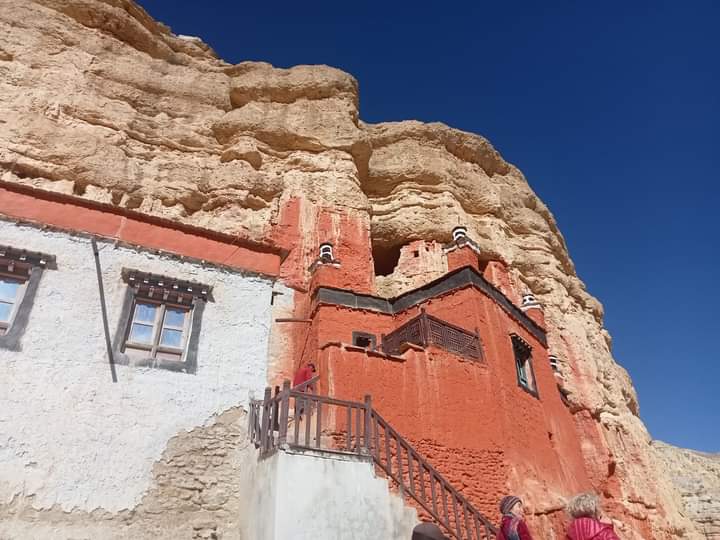
We will begin our exploration of the ethereal village of Lo Manthang with a two-hour tour of the Namgyal Gompa. Perched atop a hill, this stunning gompa holds great social, religious, and legal significance as it functions as the community’s judiciary.
Following that, we will travel to Tingkhar, a community with 40 houses located northwest of Lo Manthang. We will also go to Champa Lhakang, where you can see elaborate Mandalas painted on the walls and a big Buddha statue.
Day 9. Trek to Dhamkar
We are going to depart from Lo Manthang via the upper highland trail. We will be rewarded with breathtaking vistas of the Charang Valley and Lo Manthang, with snow-capped mountains in the distance. At 4,100 meters, we will pass the Dhi Pass and arrive in Dhamkar. We are going to stay the night here.
Day 10.Descend to Syangboche
We will hike down to Syangboche, with giants like Dhaulagiri and Nilgiri towering over us. We pass by the mysterious Rachen Gompa, which is located at the mouth of a rocky cave, en route. In Syangboche, we’ll spend the night in a guesthouse.
Day 11. Trek to Chhusang
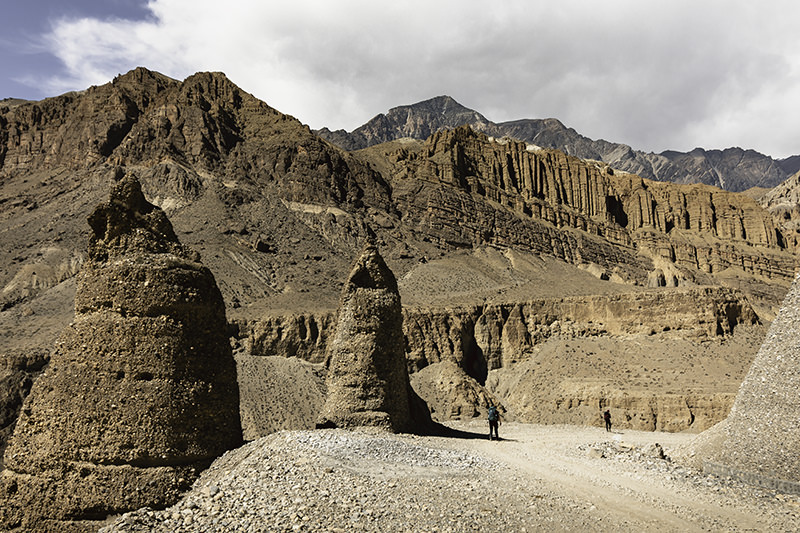
We’ll keep walking over hills and around steep ridges. We will hike to Tetang, which is located between two hills in Chhusang and is the upper village. It provides a secure haven from the strong winds that frequently batter the Kali Gandaki valley.
Day 12. Trek to Jomsom
On this day will have an amazing journey, pass via Jharkot hamlet, stop by the neighborhood monastery, tour the impressive Tibetan Herbal Medicine Center, and view an old fort that was formerly a palace. We will take in the scenery of Kagbeni Village and the Kali Gandaki Valley as we descend to Jomsom. This is how you enter a Mustang. We shall celebrate with all of our colleagues on the final day of the walk-in Jomsom.
Day 13. Flight to Pokhara
We will fly to Pokhara for twenty minutes, and then spend the remainder of the day exploring and unwinding in the city. If you haven’t already, explore the mysterious caverns, see the stunning mountaintop monastery, or go boating in the exotic Phewa, Rupa, and Begnas Lakes. You will be able to take advantage of the vibrant city’s nightlife and purchase some mementos.
Day14. Drive from Pokhara to Kathmandu
We will take the Prithvi Highway back to the capital after breakfast. Once more, the breathtaking bus ride will keep you feeling renewed the entire way. When we got to Kathmandu, we split off. I hope the remainder of your stay in Nepal is enjoyable! Salutations!
What to Expect on Upper Mustang Trek
The only tea house trip in Nepal that you may undertake without being impacted by the summertime monsoon rains is the walk-in Upper Mustang. You have to camp in similar areas that avoid the monsoon, such as Inner Dolpo and the far west of Nepal. It is not possible to complete a tea house journey with constant formal accommodations.
Are there any differences between the tea houses in Upper Mustang and other hiking destinations in Nepal? Indeed, they are. Mustang features Tibetan-style architecture, featuring distinct window frames and flat roofs. Shrubs and wood are dried on rooftops for use as fuel in the winter. Expect nothing like the luxury of the Everest Base Camp Expedition.
Even now, hardly many people visit the area, and the lodging is still quite basic yet authentic. You will therefore have the opportunity to sample regional cuisine, such as yak cheese and yak butter tea, even though WiFi and hot water might not be available. A real local experience that provides you with insight into the lives of those who live in this area is to stay at an Upper Mustang Tea House.
Conclusion
It’s important to realize that anyone can get altitude sickness, regardless of age, degree of fitness, or prior experience traveling to high altitudes. These days, you can keep an eye on your health while flying with a variety of devices. An analog approach that is frequently utilized is the Lake Louise scoring card.
It checks the symptoms of altitude while taking into account their severity. It’s a typical tool that guides use. These days, the majority of mountain and trekking guides carry a blood oxygen saturation meter that also registers heart rate. These are important markers of how successfully someone adjusts to altitude. Trekking the Upper Mustang Trek may result in AMS.
Recent Posts
